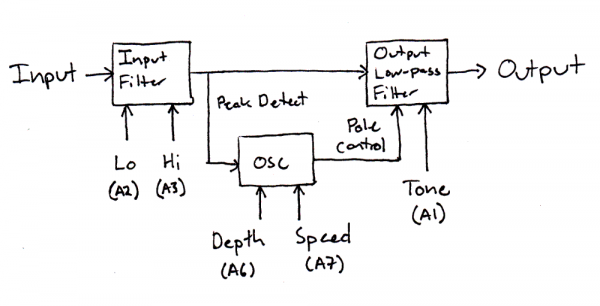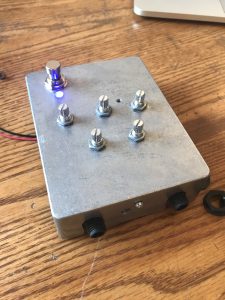Final Update
May 9th, 2018
Update #4
Output
Description
I finished the build portion of my pedal on Tuesday, and the tutorial came with some pre-made code to run on the board. After discussing my options with Ben, we decided that the software from the tutorial would be best to use. The code I am using in the pedal creates an Auto Roller effect. This simulates a rotary tone cabinet which creates a “dynamically-controlled warble.” The louder the guitar is played, the faster the oscillation of the wave. The code I used can be found here: https://github.com/sparkfun/Proto_Pedal/blob/master/projects/teensy-based/sketches/AutoRoller/AutoRoller.ino


How it works
The pedal is built with five knobs, and the Auto Roller has five different controls: tone, speed, depth, high EQ, and low EQ.

Image from https://learn.sparkfun.com/tutorials/proto-pedal-example-programmable-digital-pedal
The first stage of the effect is the input filter. Within this filter are two different parameters, low frequency control and high frequency control. These are very simple low- and high- pass filters. When the low frequency control is turned fully clockwise, all the low frequencies are passed through. When it’s turned fully counterclockwise, the low frequencies are cut out. The same happens with the high frequency control except with high frequencies.
This signal feeds into a peak detector module. The harder the guitar is hit, the faster and deeper the effect. This module changes the frequency and amplitude of the sine wave generated by the algorithm based on the input from the guitar, and this is the most interesting section of the effect. In addition to the dynamic control of the sine wave’s oscillation, the algorithm also includes a frequency oscillator that can be controlled by the knobs. The depth knob changes the amplitude of the sine wave. Fully clockwise, the effect is in full force and extremely noticeable. Counterclockwise, it’s basically off. The speed knob changes the frequency of the sine wave. Clockwise, the warbling effect is faster. Counterclockwise, it isn’t noticeable.
Finally the signal is passed through another low-pass filter that control the overall tone of the effect. The tone knob changes the cut-off frequencies when engaged. Like any low-pass filter, when the tone knob is turned counterclockwise, all the high frequencies are cut and creates an interesting sound like a whale under water. When turned fully clockwise, the tone knob doesn’t attenuate any frequencies. Additionally, this knob also changes the resonance of the effect. When it is fully clockwise, the knob has very little resonance, so the effect is barely noticeable. The opposite occurs when the knob is counterclockwise, and the effect is very noticeable.
Performance
The pedal works really well. The auto-roller that sounds amazing, and it is really versatile. I’m glad that the electronics work and the Teensy is able to download the code I want to run. Some little things are slightly off with the sound, though. Unfortunately, the noise floor of the Teensy is raised, so when the pedal is plugged in, there is a slight buzzing sound. This is due to the Teensy itself. It also could be due to the fact that I used non-audio specific capacitors which Jim said might have an effect on the output. However, when I play guitar, it isn’t noticeable. I don’t have much to base the performance of the pedal off other than my own store-bought pedals, but compared to those, my pedal actually sounds like a professionally made pedal. The effects sound as good as any pedal I’ve used, and I’m excited to add this to my board.
Reflection
Through this process, I learned a lot about circuitry, electrical engineering, and effects. Before this class, I had no knowledge of engineering in any regard, and this project helped me understand the things we learned in class on a deeper level. I certainly applied the concepts of circuitry that we learned throughout the class. I didn’t really have a grasp on the concepts while we were in class, but this process helped me develop a deeper understanding. Additionally, I applied many of the concepts we learned with regards to effects, filters, oscillators, and coding. These are things I had a better grasp on, but I still gained a lot from this experience.
Additional pictures



